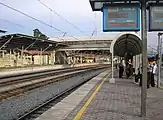| Klang Valley Integrated Transit System | |||
|---|---|---|---|
| Overview | |||
| Native name | Sistem Transit Bersepadu Lembah Klang (Malay) | ||
| Locale | Klang Valley | ||
| Transit type | Commuter rail, rapid transit & bus rapid transit | ||
| Number of lines | 16 (12 in operation, 2 under construction and 2 shelved) | ||
| Number of stations | 177 transit stations | ||
| Daily ridership | 786,251 (2019[1]) | ||
| Annual ridership | 245,238,163 (2019[1]) for Line 3 4 5 6 7 8 9 | ||
| Operation | |||
| Began operation | 14 August 1995 | ||
| Operator(s) | |||
| Technical | |||
| System length | 555.7 km (345 mi) | ||
| Track gauge | |||
| Electrification |
| ||
| |||
The Klang Valley Integrated Transit System is an integrated transport network that primarily serves the area of Klang Valley and Greater Kuala Lumpur. The system currently consists of 12 fully operating rail lines; two commuter rail lines, six rapid transit lines, one bus rapid transit line and two airport rail links to the Kuala Lumpur International Airport's (KLIA) Terminal 1 and Terminal 2, and another one to the Sultan Abdul Aziz Shah Airport.
History

Initially, different competing companies operated the various transit systems and had developed these rail and bus systems separately and at various times.
As a result, many of these systems did not integrate well with the others, making transferring from system to system inconvenient for passengers.
Aggravated by Kuala Lumpur's poor pedestrian network, moving from one rail system to another often required a lot of walking, stair-climbing, and escalator-use.
Integrated tickets for all rail-based systems called the Touch 'n Go cards allow passengers to transfer seamlessly across all stations and lines in the Klang Valley region.
Integration
Since 28 November 2011, the paid areas of shared stations along the Rapid KL system for the Kelana Jaya Line, Ampang Line, and Sri Petaling Line, as well as the KL Monorail from 1 March 2012, have been integrated physically under a common ticketing system, effectively making those stations interchange stations. This enables commuters to transfer between lines the interchange stations without buying a new ticket each time, provided that they do not exit the paid area. This is currently possible at the Titiwangsa, Hang Tuah, Putra Heights, and Masjid Jamek stations. With the opening of the latest rapid transit lines on 17 July 2017 and 16 June 2022, the Kajang Line and Putrajaya Line respectively, the integrated system has been expanded to Pasar Seni, Merdeka-Plaza Rakyat, Maluri, Tun Razak Exchange, Chan Sow Lin and Sungai Besi stations, and to USJ 7 station with the launching of the BRT Sunway Line.
The Touch 'n Go stored value fare card is accepted as a mode of payment on the Rapid Bus system, LRT, MRT, BRT, and monorail lines, as well as the KTM Komuter, easing the hassle of buying separate tickets for travelling on different networks. However, the fare integration for the Rapid KL system does not include other rail systems such as KTM Komuter and Express Rail Link.
Rapid Rail, the operator of the LRT, MRT, monorail, BRT lines, and Rapid Bus (which covers about 70% of the Klang Valley's bus network), has launched a daily bus ticket which costs as low as RM1, and an integrated transit daily pass which can be used on both its rail and bus services costing RM7.
System network
The KTM Komuter, a commuter rail service, was introduced in 1995 as the first rail transit system to provide local rail services in Kuala Lumpur and the surrounding Klang Valley suburban areas. Light rapid transit (LRT) lines and monorail line were introduced later on to serve the urban Kuala Lumpur area and its satellite towns. (i.e. Ampang, Petaling Jaya, Subang Jaya, Puchong, Gombak, etc) The mass rapid transit (MRT) lines aims to connect the outskirts of the Klang Valley (i.e. Damansara, Sungai Buloh, Putrajaya, Kajang) with the city centre. Malaysia's first bus rapid transit (BRT) line was introduced to ease pedestrian traffic in Bandar Sunway, a thriving leisure and entertainment township in Subang Jaya. 2 airport rail links connect the city centre with the 2 major airports of the Klang Valley, two to the Kuala Lumpur International Airport (KLIA) Terminal 1 and 2, and one to the Sultan Abdul Aziz Shah Airport.
Proposed and future lines

The fourth LRT line, the Shah Alam Line is also under the construction phase.[5] The construction of the third KVMRT line, the Circle Line is expected to commence in 2023.[6]
| Line Number | Line Name | Stations | Length | Status | Planned Opening | Terminus | |
|---|---|---|---|---|---|---|---|
| 11 | Shah Alam Line | 25 | 37 km | Under Construction | 1 March 2025 | KG09 SA01 Bandar Utama |
SA26 Johan Setia |
| 13 | Circle Line | 31 | 50.8 km | Approved and awaiting for tender stage[7] | Phase 1: December 2028 | CC01 KG12A Bukit Kiara Selatan |
TBA |
| Phase 2: 2030 | TBA | CC31 UM | |||||
| 14 | Putrajaya Monorail | 25 | TBA | Under planning for new proposed LRT line[8][9] | TBA | KB06 KG35 Kajang |
Bandar Cyberjaya |
| B2 | BRT Federal Line | 24 | 32.52 km | Shelved on 28 November 2017 | N/A | KJ14 KG16 FB01 Pasar Seni |
KD14 SA20 FB24 Klang |
Rolling stock
| Line Code | Line Name | Formation | In service On order |
Rolling Stock | Manufacturers | Image |
|---|---|---|---|---|---|---|
| 1 | Batu Caves-Pulau Sebang Line | 6 carriage EMU | 37 trainsets (222 car) | KTM Class 92 |  | |
| 2 | Tanjung Malim-Port Klang Line | |||||
| 3 | Ampang Line | 6 carriage high-floor LRV | 50 trainsets (300 car) | CRRC Zhuzhou LRV "AMY" |  | |
| 4 | Sri Petaling Line | |||||
| 5 | Kelana Jaya Line | 2 carriage Linear induction EMU | 35 trainsets (70 car) | Bombardier Innovia ART 200 |  | |
| 4 carriage Linear induction EMU | 35 trainsets (140 car) | |||||
| 14 trainsets (56 car) 27 trainsets (108 car) |
Bombardier Innovia Metro 300 | *Consortium |
 | |||
| 6 | KLIA Ekspres | 4 carriage EMU | 8 trainsets (32 car) | Siemens Desiro ET 425 M | 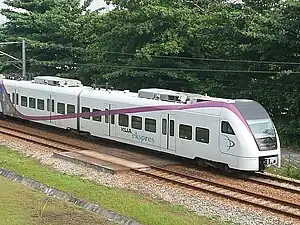 | |
| 2 trainsets (8 car) | CRRC Changchun "Equator EMU" | 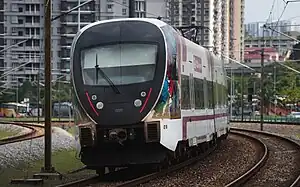 | ||||
| 7 | KLIA Transit | 4 trainsets (16 car) | Siemens Desiro ET 425 M | |||
| 4 trainsets (16 car) | CRRC Changchun "Equator EMU" | 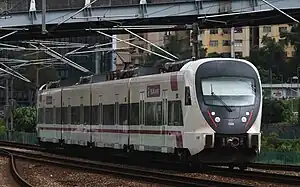 | ||||
| 8 | KL Monorail | 4 carriage monorail EMU | 9 trainsets (36 car) | Scomi SUTRA |  | |
| 9 | Kajang Line | 4 carriage EMU | 58 trainsets (232 car) | Siemens Inspiro "The Guiding Light" | *Consortium |
 |
| 10 | KL Sentral-Terminal Skypark Line | 3 carriage EMU | 4 trainsets (12 car) | KTM Class 83 |  | |
| 11 | Shah Alam Line | 3 carriage LRV | 25 trainsets (75 car) | CRRC Zhuzhou LRV | *Consortium |
|
| 12 | Putrajaya Line | 4 carriage EMU | 49 trainsets (196 car) | Hyundai Rotem EMU "Ducky" | *Consortium |
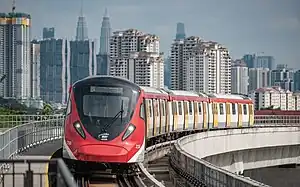 |
| B1 | BRT Sunway Line | Single-deck bus | 15 battery run-electric bus | BYD K9 | 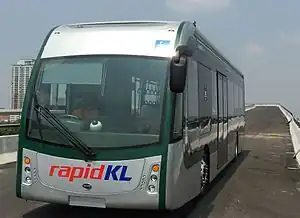 |
Gallery
Notes
References
- 1 2 "Statistik Rel 2019" (PDF). Ministry of Transport (Malaysia). Archived from the original (PDF) on 22 April 2020.
- ↑ "Kelana Jaya Line". Prasarana Malaysia. Archived from the original on 30 March 2014. Retrieved 12 June 2014.
- ↑ "KL Monorail Line". Syarikat Prasarana Negara. Archived from the original on 30 March 2014. Retrieved 12 June 2014.
- ↑ Razak Ahmad, Hemananthani Sivanandam (17 July 2017). "Najib launches Phase 2 of Sungai Buloh-Kajang MRT line". The Star.
- ↑ Ali, Sharidan M (13 December 2014). "Prasarana to roll out LRT 3 projects by second half of 2015 - Business News | The Star Online". Thestar.com.my. Retrieved 15 April 2015.
- ↑ "MASS RAPID TRANSIT LINE 3: CIRCLE LINE - DRAFT". Retrieved 1 September 2021.
- ↑ "MRT 3 tender to be opened this year, says Dr Wee". The Star. Retrieved 15 March 2022.
- ↑ "Kajang-Putrajaya rail link may be revived | The Star Online". www.thestar.com.my.
- ↑ Sulaiman, Noor Atiqah (19 April 2019). "Monorail project in Putrajaya to go on". NST Online.



_(cropped).jpg.webp)
_(cropped).jpg.webp)

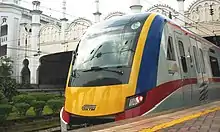
_(front)%252C_Seremban.jpg.webp)
